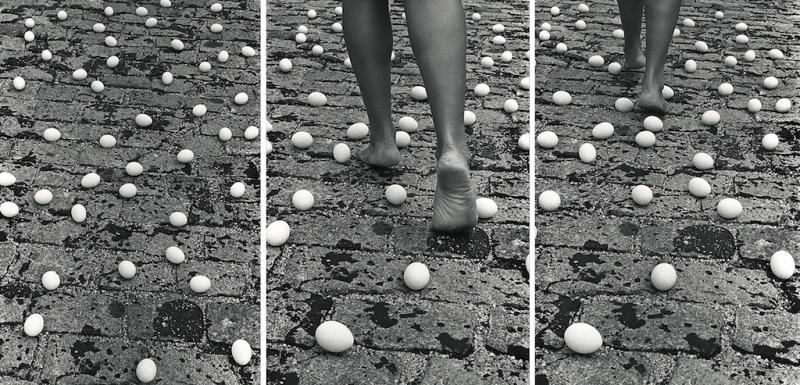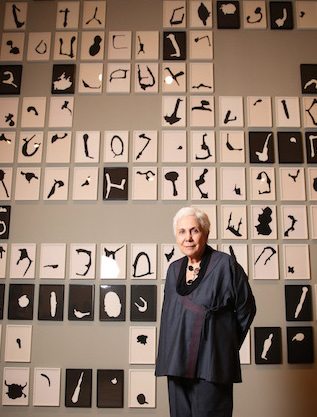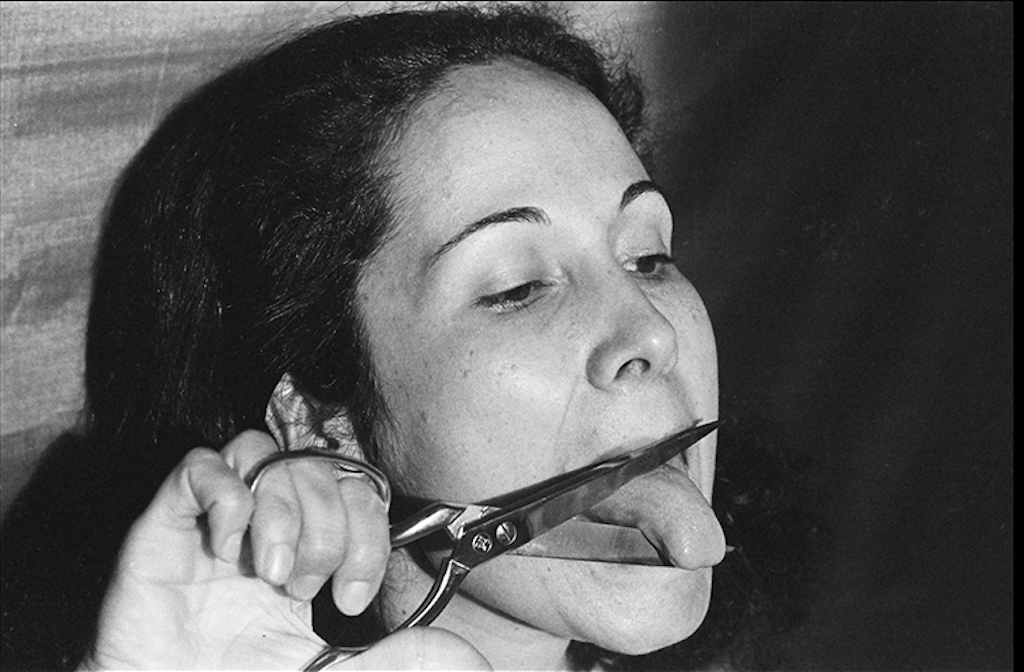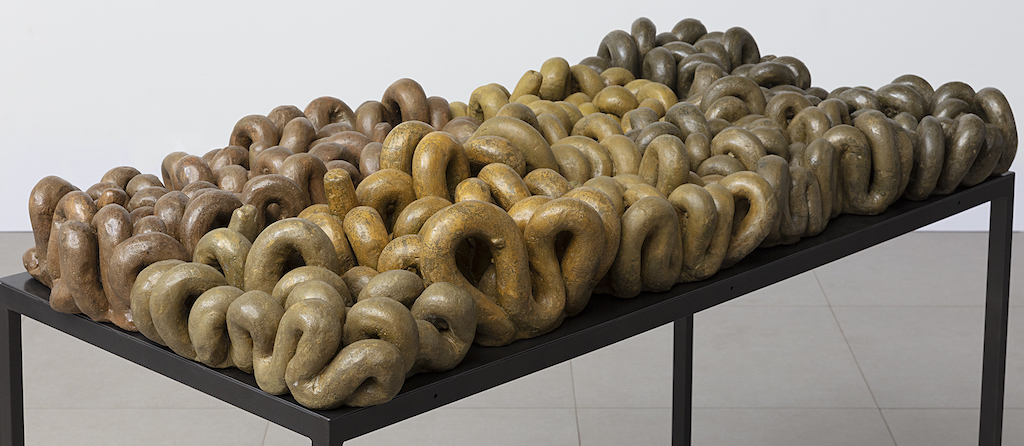Anna Maria Maiolino: Making Love Revolutionary, Whitechapel Gallery review – a gentle rebellion | reviews, news & interviews
Anna Maria Maiolino: Making Love Revolutionary, Whitechapel Gallery review – a gentle rebellion
Anna Maria Maiolino: Making Love Revolutionary, Whitechapel Gallery review – a gentle rebellion
A career that evolves from silent resistance to celebration

Now in her mid-seventies, Anna Maria Maiolino has been making work for six decades. Its a long stretch to cover in an exhibition, especially when the artist is not well known. Perhaps inevitably, then, this Whitechapel Gallery retrospective seems somewhat sketchy and opaque, a feeling compounded by having titles in Portuguese.
Puzzling over this odd feeling of disconnect, it occurred to me that it is central to Maiolino’s practice. Born in Italy, she moved to Venezuela at the age of 12, to Brazil in 1960 aged 18 and then to the States before returning to Brazil in 1971. Every few years, then, she was confronted with the challenge of learning a new language and adjusting to a new culture, and that experience of otherness infiltrates her work.
 In New York, unable to speak English and stuck at home looking after her children, she began keeping a journal documenting mundane domestic tasks in drawings she described as a “record of existing”. Not able to engage fully with the social and cultural scene, she focused attention on her immediate experiences. And to this day, activities traditionally associated with ”women’s work”, such as sewing, making pastry and baking, are an ongoing sources of inspiration.
In New York, unable to speak English and stuck at home looking after her children, she began keeping a journal documenting mundane domestic tasks in drawings she described as a “record of existing”. Not able to engage fully with the social and cultural scene, she focused attention on her immediate experiences. And to this day, activities traditionally associated with ”women’s work”, such as sewing, making pastry and baking, are an ongoing sources of inspiration.
Traces, 2000-2013 is an exquisite set of drawings made with black and red thread stitched through paper to create double sided images reminiscent of the dot to dot drawings I loved as a child. Parallel lines, zig zags and crosses create intricate webs whose endless variety is a sheer delight. Elsewhere paper becomes a sculptural material which she cuts, folds, tears, burns and layers into reliefs that feel both robust and vulnerable. In Untitled 1977, black thread is sewn across a tear to read both as a line drawing and a suture repairing a wound. Cut and burned out of black paper, the silhouettes of Italy and South America are like an exorcism – acts of controlled fury mingled with regret.
Made from unfired clay, her most recent sculptures are like celebrations of the body and its many desires. She kneads, rolls, coils, balls and slices the clay into shapes resembling sausages, pastries and pasta. Some of these treats are laid out like market produce (pictured below: Nine Segments 1998. Photo: Everton Ballardin), while others are piled on the floor or propped against the wall. Just inside the door is nearly a ton of clay shaped into phallic loops. Piled up and left to dry, crack and eventually crumble into dust, this visceral heap evokes the journey made by foodstuffs from field to market to table and from mouth to anus, and also the cycle of life (dust to dust).
 Some sculptures are like mini landscapes. One block resembles a limestone pavement shaped by rainwater into spiky protuberances and convoluted runnels; others seem infested by insects that have nibbled out a warren of intersecting chambers.
Some sculptures are like mini landscapes. One block resembles a limestone pavement shaped by rainwater into spiky protuberances and convoluted runnels; others seem infested by insects that have nibbled out a warren of intersecting chambers.
Language, or the difficulty of communication, Is another recurring theme. A series of pictograms, made by dropping ink onto paper, invite you to decipher them, if only you had the key (pictured above right: Maiolino with Untitled, 2000 from the series Drop Marks). Maiolino lived through twenty years of military dictatorship (1964-85) when secrecy and self censorship were essential for survival. In a series of photographs, she appears gagged and blindfolded and, more dramatically still, enacts cutting off her nose and tongue. (Pictured above left: What is Left Over, from the series Photopoemaction. Photo by Max Nauenberg). In the silent film In-Out, 1973/2000 she hones in on the mouths of a man and woman who smile, grimace, purse their lips and bear their teeth – going through the motions, without actually communicating anything. Its a surreal experience – like trying to understand a foreign language by reading someone’s lips – that evokes the disconnect of being silenced.
 Most memorable of all is a photograph taken in 1981 of the artist walking barefoot across a field of eggs, literally walking on eggshells (main picture). The three frames show her traversing this delicate minefield and almost reaching the other side; but before one gets too triumphalist about overcoming adversity, it does well to recall that Brazilians have recently elected into power another right wing regime, which makes this exhibition of Maiolino’s poetic work especially relevant and timely.
Most memorable of all is a photograph taken in 1981 of the artist walking barefoot across a field of eggs, literally walking on eggshells (main picture). The three frames show her traversing this delicate minefield and almost reaching the other side; but before one gets too triumphalist about overcoming adversity, it does well to recall that Brazilians have recently elected into power another right wing regime, which makes this exhibition of Maiolino’s poetic work especially relevant and timely.
- Anna Maria Maiolino: Making Love Revolutionary at the Whitechapel Gallery until 12 January
- More visual arts reviews on theartsdesk
rating
Share this article
The future of Arts Journalism
You can stop theartsdesk.com closing!
We urgently need financing to survive. Our fundraising drive has thus far raised £49,000 but we need to reach £100,000 or we will be forced to close. Please contribute here: https://gofund.me/c3f6033d
And if you can forward this information to anyone who might assist, we’d be grateful.

Subscribe to theartsdesk.com
Thank you for continuing to read our work on theartsdesk.com. For unlimited access to every article in its entirety, including our archive of more than 15,000 pieces, we're asking for £5 per month or £40 per year. We feel it's a very good deal, and hope you do too.
To take a subscription now simply click here.
And if you're looking for that extra gift for a friend or family member, why not treat them to a theartsdesk.com gift subscription?
more Visual arts
 'We are bowled over!' Thank you for your messages of love and support
Much-appreciated words of commendation from readers and the cultural community
'We are bowled over!' Thank you for your messages of love and support
Much-appreciated words of commendation from readers and the cultural community
![SEX MONEY RACE RELIGION [2016] by Gilbert and George. Installation shot of Gilbert & George 21ST CENTURY PICTURES Hayward Gallery](https://theartsdesk.com/sites/default/files/styles/thumbnail/public/mastimages/Gilbert%20%26%20George_%2021ST%20CENTURY%20PICTURES.%20SEX%20MONEY%20RACE%20RELIGION%20%5B2016%5D.%20Photo_%20Mark%20Blower.%20Courtesy%20of%20the%20Gilbert%20%26%20George%20and%20the%20Hayward%20Gallery._0.jpg?itok=7tVsLyR-) Gilbert & George, 21st Century Pictures, Hayward Gallery review - brash, bright and not so beautiful
The couple's coloured photomontages shout louder than ever, causing sensory overload
Gilbert & George, 21st Century Pictures, Hayward Gallery review - brash, bright and not so beautiful
The couple's coloured photomontages shout louder than ever, causing sensory overload
 Lee Miller, Tate Britain review - an extraordinary career that remains an enigma
Fashion photographer, artist or war reporter; will the real Lee Miller please step forward?
Lee Miller, Tate Britain review - an extraordinary career that remains an enigma
Fashion photographer, artist or war reporter; will the real Lee Miller please step forward?
 Kerry James Marshall: The Histories, Royal Academy review - a triumphant celebration of blackness
Room after room of glorious paintings
Kerry James Marshall: The Histories, Royal Academy review - a triumphant celebration of blackness
Room after room of glorious paintings
 Folkestone Triennial 2025 - landscape, seascape, art lovers' escape
Locally rooted festival brings home many but not all global concerns
Folkestone Triennial 2025 - landscape, seascape, art lovers' escape
Locally rooted festival brings home many but not all global concerns
 Sir Brian Clarke (1953-2025) - a personal tribute
Remembering an artist with a gift for the transcendent
Sir Brian Clarke (1953-2025) - a personal tribute
Remembering an artist with a gift for the transcendent
 Emily Kam Kngwarray, Tate Modern review - glimpses of another world
Pictures that are an affirmation of belonging
Emily Kam Kngwarray, Tate Modern review - glimpses of another world
Pictures that are an affirmation of belonging
 Kiefer / Van Gogh, Royal Academy review - a pairing of opposites
Small scale intensity meets large scale melodrama
Kiefer / Van Gogh, Royal Academy review - a pairing of opposites
Small scale intensity meets large scale melodrama
 Jenny Saville: The Anatomy of Painting, National Portrait Gallery review - a protégé losing her way
A brilliant painter in search of a worthwhile subject
Jenny Saville: The Anatomy of Painting, National Portrait Gallery review - a protégé losing her way
A brilliant painter in search of a worthwhile subject
 Abstract Erotic, Courtauld Gallery review - sculpture that is sensuous, funny and subversive
Testing the boundaries of good taste, and winning
Abstract Erotic, Courtauld Gallery review - sculpture that is sensuous, funny and subversive
Testing the boundaries of good taste, and winning
 Edward Burra, Tate Britain review - watercolour made mainstream
Social satire with a nasty bite
Edward Burra, Tate Britain review - watercolour made mainstream
Social satire with a nasty bite
 Ithell Colquhoun, Tate Britain review - revelations of a weird and wonderful world
Emanations from the unconscious
Ithell Colquhoun, Tate Britain review - revelations of a weird and wonderful world
Emanations from the unconscious

Add comment